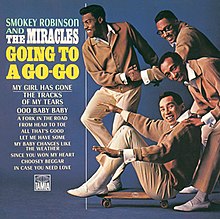| Going to a Go-Go | ||||
|---|---|---|---|---|
 | ||||
| Studio album by | ||||
| Released | November 1, 1965 | |||
| Recorded | 1963–1965 | |||
| Studio | Hitsville USA, Detroit | |||
| Genre | Soul[1] | |||
| Length | 33:49 | |||
| Label | Tamla | |||
| Producer | Smokey Robinson | |||
| Smokey Robinson & the Miracles chronology | ||||
| ||||
| Singles from Going to a Go-Go | ||||
| ||||
| Review scores | |
|---|---|
| Source | Rating |
| Allmusic | |
| Record Mirror | |
Going to a Go-Go is the seventh studio album by the American R&B group Smokey Robinson and the Miracles.[nb 1] It was released on November 1, 1965, in the United States on Motown's Tamla label.[5] It includes four of the Miracles' Top 20 hits: "Ooo Baby Baby", "The Tracks of My Tears", "Going to a Go-Go", and "My Girl Has Gone".
Going to a Go-Go was the only Miracles studio LP to chart within the Top 10 of the Billboard Top LPs chart, where it remained for 40 weeks, peaking at number 8. The LP peaked at number-one on Billboard's R&B albums chart. In 2003, the album achieved Gold Record status.[citation needed] It was ranked number 271 on Rolling Stone magazine's list of the 500 greatest albums of all time,[6] and number 273 in the 2012 revised list, and number 412 in the 2020 revised list.[7][8]
Going to a Go-Go was reissued on CD in 2002, coupled with the Miracles' Away We a Go-Go.
- ^ Segretto, Mike (2022). "1965". 33 1/3 Revolutions Per Minute - A Critical Trip Through the Rock LP Era, 1955–1999. Backbeat. pp. 72–73. ISBN 9781493064601.
- ^ Allmusic review
- ^ Jones, Peter; Jopling, Norman (26 February 1966). "The Miracles: Going To A Go Go" (PDF). Record Mirror. No. 259. p. 8. Archived from the original (PDF) on 1 April 2022. Retrieved 22 August 2022.
- ^ MOJO Staff (September 12, 2023). "The Best Motown Albums Ranked". MOJO. Archived from the original on September 9, 2024.
Going To A Go-Go was the first Miracles album to feature its lead singer and main songwriter's name out-front.
- ^ Cite error: The named reference
DFMC2018was invoked but never defined (see the help page). - ^ "News". Rolling Stone. Archived from the original on March 13, 2007. Retrieved 2011-12-05.
- ^ "500 Greatest Albums of All Time Rolling Stone's definitive list of the 500 greatest albums of all time". Rolling Stone. 2012. Retrieved September 10, 2019.
- ^ "The 500 Greatest Albums of All Time". Rolling Stone. 2020-09-22. Retrieved 2020-11-11.
Cite error: There are <ref group=nb> tags on this page, but the references will not show without a {{reflist|group=nb}} template (see the help page).
